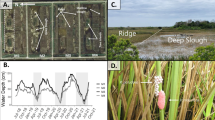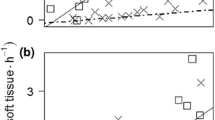Abstract
Recent studies suggest native aquatic predators can favor native over invasive species and provide biotic resistance to invasions. The invasive apple snail, Pomacea maculata continues to spread in freshwaters of Florida and appears to be a strong competitor of the native Florida apple snail (P. paludosa). Little is known about effects of predators on either species and we compared the effects of a common native crayfish predator (Procambarus fallax) on hatchlings and juveniles. Because crayfish feed size-selectively, we predicted that the smaller P. maculata hatchlings would be more vulnerable than the hatchlings of native P. paludosa. In experimental wetland mesocosms, crayfish reduced survival of both species, but none of the P. maculata survived the 44 days exposure, such that predatory effects of crayfish were >8× stronger on the non-native P. maculata than on native P. paludosa. Crayfish in the lab selectively consumed the smaller P. maculata when offered both hatchlings simultaneously. We combined the observed survival rates with published life history data and the results (i.e., projected survivors clutch−1) suggested that wetlands with crayfish could have greater limiting effects on non-native P. maculata than the native P. paludosa. Wetland conditions favoring populations of native crayfish may also favor the relatively predator-resistant native P. paludosa.


Similar content being viewed by others
References
Alofs KM, Jackson DM (2014) Meta-analysis suggests biotic resistance in freshwater environments is driven by consumption rather than competition. Ecology 95:3259–3270
Bajer PG, Chizinski CJ, Silbernagel JJ, Sorensen PW (2012) Variation in native micro-predator abundance explains recruitment of a mobile invasive fish, the common carp, in a naturally unstable environment. Biol Invasions 14:1919–1929
Barnes MA, Fordham RK, Burks RL, Hand JJ (2008) Fecundity of the exotic apple snail, Pomacea insularum. J N Am Benth Soc 27:738–745
Berlow EL, Navarrete SA, Briggs CJ, Power ME, Menge BA (1999) Quantifying variation in the strengths of species interactions. Ecology 80:2206–2224
Bernatis JL, Warren GL (2014) Effectiveness of a hand removal program for management of nonindigenous apple snails in an urban pond. Southeast Nat 13:607–618
Bishop MJ, Peterson CH (2006) When r-selection may not predict introduced-species proliferation: predation of a nonnative oyster. Ecol Appl 16:718–730
Brown KM (1998) The role of shell strength in selective foraging by crayfish for gastropod prey. Freshw Biol 40:255–260
Burlakova LE, Padilla DK, Karatayev AY, Hollas DN, Cartwright LD, Nichol KD (2010) Differences in population dynamics and potential impacts of a freshwater invader driven by temporal habitat stability. Biol Invasions 12:927–941
Carlsson NOL, Brönmark C, Hansson L-A (2004) Invading herbivory: the golden apple snail alters ecosystem functioning in Asian wetlands. Ecology 85:1575–1580
Carlsson NOL, Sarnelle O, Strayer DL (2009) Native predators and exotic prey—an acquired taste? Front Ecol Environ 10:525–532
Carlsson NOL, Bustamante H, Strayer DL, Pace ML (2011) Biotic resistance on the increase: native predators structure invasive zebra mussel populations. Freshw Biol 56:1630–1637
Cattau CE, Martin J, Kitchens WM (2010) Effects of an exotic prey species on a native specialist: example of the snail kite. Biol Conserv 143:513–520
Cheng BS, Hovel KA (2010) Biotic resistance to invasion along an estuarine gradient. Oecologia 164:1049–1059
Chesson J (1983) The estimation and analysis of preference and its relationship to foraging models. Ecology 64:1297–1304
Colautti CI, Ricciardi A, Grigorovich IA, MacIsaac HJ (2004) Is invasion success explained by the enemy-release hypothesis? Ecol Lett 7:721–733
Conner SL, Pomory CM, Darby PC (2008) Density effects of native and exotic snails on growth in juvenile apple snails Pomacea paludosa (Gastropoda: Ampullaridae): a laboratory experiment. J Molluscan Stud 74:355–362
Darby PC, Bennetts RE, Croop JD, Valentine-Darby PL, Kitchens WM (1999) A comparison of sampling techniques for quantifying abundance of the Florida apple snail (Pomacea paludosa Say). J Moll Stud 65:195–208
deRiviera CE, Ruiz GM, Hines AH, Jivoff P (2005) Biotic resistance to invasion: native predator limits abundance and distribution of an introduced crab. Ecology 86:3364–3376
Dorn NJ (2013) Consumptive effects of crayfish limit snail populations. Freshw Sci 32:1298–1308
Dorn NJ, Trexler JC (2007) Crayfish assemblage shifts in a large drought-prone wetland: the roles of hydrology and competition. Freshw Biol 52:2399–2411
Dorn NJ, Volin JC (2009) Resistance of crayfish (Procambarus spp.) populations to wetland drying depends on species and substrate. J N Am Benthol Soc 28:766–777
Elton CS (1958) The ecology of invasions. University of Chicago Press, Chicago
Englund G (1999) Effects of fish on the local abundance of crayfish in stream pools. Oikos 87:48–56
Fletcher R, Robertson E, Reichert B, Cattau C, Wilcox R, Zweig C, Jeffrey B, Olbert J, Pias K, Kitchens W (2015) Snail kite demography 5-year report. Prepared for the U.S. Army Corps of Engineers
Hayes KA, Cowie RH, Thiengo SC, Strong EE (2012) Comparing apples to apples: clarifying the identities of two highly invasive Neotropical Ampullaridae (Caenogastropoda). Zool J Linn Soc 166:723–753
Horgan FG, Stuart AM, Kudavidanage EP (2014) Impact of invasive apple snails on the functioning and services of natural and managed wetlands. Acta Oecol 54:90–100
Johnson PTJ, Olden JD, Solomon CT, VanderZanden MJ (2009) Interactions among invaders: community and ecosystem effects of multiple invasive species in an aquatic system. Oecologia 159:161–170
Juliano SA, Lounibos LP, Nishimura N, Greene K (2010) Your worst enemy could be your best friend: predator contributions to invasion resistance and persistence of natives. Oecologia 162:709–718
Karunaratne LB, Darby PC, Bennetts RE (2006) The effects of wetland habitat structure on Florida apple snail density. Wetlands 26:1143–1150
Kellogg CM, Dorn NJ (2012) Consumptive effects of fish reduce wetland crayfish recruitment and drive species turnover. Oecologia 168:1111–1121
Kimbro DL, Cheng BS, Grosholz ED (2013) Biotic resistance in marine environments. Ecol Lett 16:821–833
Kyle C, Plantz AL, Shelton T, Burks RL (2013) Count your eggs before they invade: identifying and quantifying egg clutches of two invasive apple snail species (Pomacea). PLoS One 8:e77736
Parkos JJ, Ruetz CR, Trexler JC (2011) Disturbance regime and limits on benefits of refuge use for fishes in a fluctuating hydroscape. Oikos 120:1519–1530
Posch H, Garr AL, Pierce R, Davis M (2012) The effect of stocking density on the reproductive output of hatchery-reared Florida apple snails, Pomacea paludosa. Aquaculture 360–361:37–40
Posch H, Garr AL, Reynolds E (2013) The presence of an exotic snail, Pomacea maculata, inhibits growth of juvenile Florida apple snails, Pomacea paludosa. J Molluscan Stud 79:383–385
Rawlings TA, Hayes KA, Cowie RH, Collins TM (2007) The identity distribution, and impacts of non-native apple snails in the continental United States. Evol Biol 7:97
Rehage JS, Trexler JC (2006) Assessing the net effects of anthropogenic disturbance on aquatic communities in wetlands: community structure relative to distance from canals. Hydrobiologia 569:359–373
Richardson CJ (2010) The everglades: North America’s subtropical wetland. Wetl Ecol Manag 18:517–542
Rogevich EC, Hoang TC, Rand GM (2009) Effects of sublethal chronic copper exposure on the growth and reproductive success of the Florida apple snail. Arch Environ Contam Toxicol 56:450–458
Ruehl CB, Trexler JC (2011) Comparison of snail density, standing stock, and body size between Caribbean karst wetlands and other freshwater ecosystems. Hydrobiologia 665:1–13
Sokal RR, Rohlf J (1995) Biometry, 3rd edn. W. H. Freeman, New York
Turner AM, Fefferolf SA, Bernot RJ (1999a) Predator identity and consumer behavior: differential effects of fish and crayfish on the habitat use of a freshwater snail. Oecologia 118:242–247
Turner AM, Trexler JC, Jordan CF, Slack SJ, Geddes P, Chick JH, Loftus WF (1999b) Targeting ecosystem features for conservation: standing crops in the Florida Everglades. Conserv Biol 13:898–911
Warton DI, Hui FK (2011) The arcsine is asinine: the analysis of proportions in ecology. Ecology 92:3–10
Yamanishi Y, Yoshida K, Fujimori N, Yusa Y (2012) Predator-driven biotic resistance and propagule pressure regulate the invasive apple snail Pomacea canaliculata in Japan. Biol Invasions 14:1343–1352
Youens AK, Burks RL (2008) Comparing applesnails with oranges: the need to standardize measuring techniques when studying Pomacea. Aquat Ecol 42:679–684
Yusa Y, Sugiura N, Wada T (2006) Predatory potential of freshwater animals on an invasive agricultural pest, the apple snail Pomacea canaliculata (Gastropoda: Ampullaridae) in southern Japan. Biol Invasions 8:137–147
Zuharah WF, Lester PJ (2011) Are exotic invaders less susceptible to native predators? A test using native and exotic mosquito species in New Zealand. Popul Ecol 53:307–317
Acknowledgments
We thank J. Bransky, N. Knorp and D. Robles for help in various parts of this project. Three anonymous reviewers improved earlier versions of the manuscript. This work was carried out in accordance with Florida Atlantic University institutional animal care and use protocol #A13-08. All P. maculata were killed at the end of this study. FAU provided undergraduate educational research funds to make this work possible.
Author information
Authors and Affiliations
Corresponding author
Rights and permissions
About this article
Cite this article
Dorn, N.J., Hafsadi, M. Native crayfish consume more non-native than native apple snails. Biol Invasions 18, 159–167 (2016). https://doi.org/10.1007/s10530-015-0998-9
Received:
Accepted:
Published:
Issue Date:
DOI: https://doi.org/10.1007/s10530-015-0998-9




